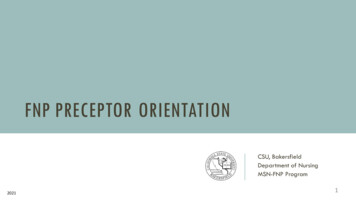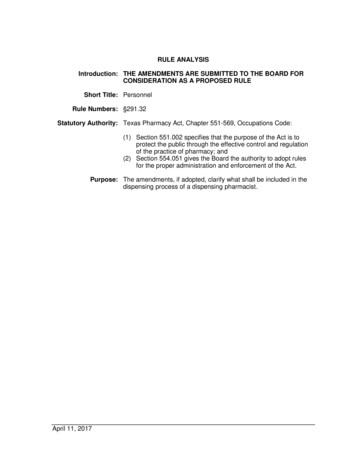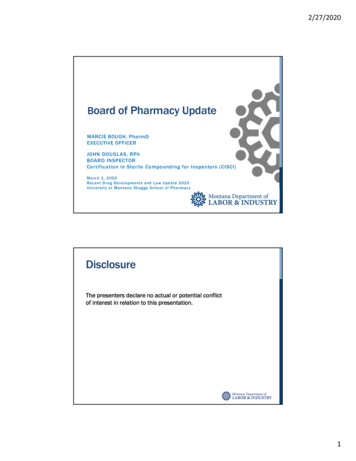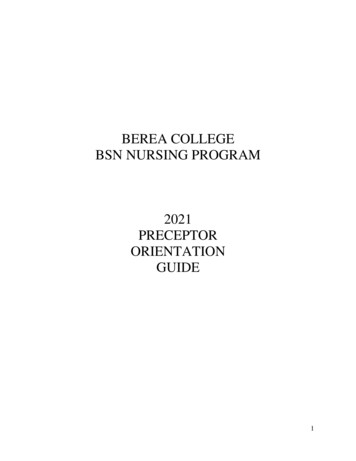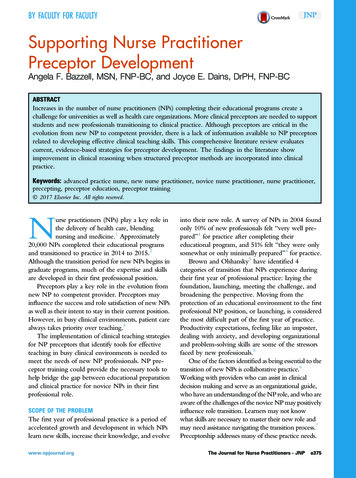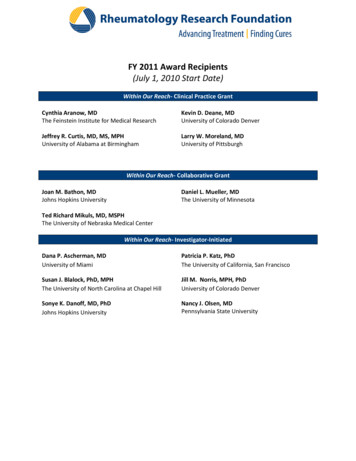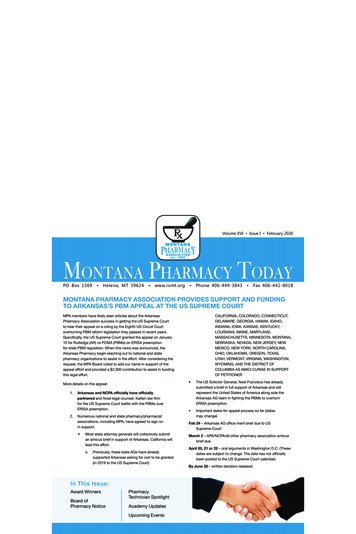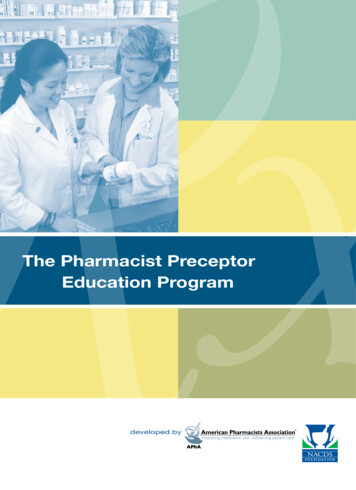
Transcription
xRThe Pharmacist PreceptorEducation Programdeveloped by
The Pharmacist Preceptor Education ProgramAdvisorCynthia J. Boyle, PharmD, FAPhAProfessor and ChairDepartment of Pharmacy Practice and AdministrationSchool of PharmacyUniversity of Maryland, Eastern ShorePrincess Anne, MarylandTable of ContentsADVISORY BOARD FROM 2007Co-chairMaryann Z. Skrabal, PharmD,CDEAssistant DirectorOffice of Experiential EducationAssistant ProfessorDepartment of PharmacyPracticeSchool of Pharmacy and HealthProfessionsCreighton UniversityOmaha, NebraskaRebecca L. Hefele, RPhDirector of Specialty PharmacyMedicine Shoppe InternationalInc.Earth City, MissouriCo-chairJaneen Winnike, BPharmDirector of Recruiting andCollege RelationsSuperValuFranklin Park, IllinoisPhilip M. Hritcko, PharmDAssistant Clinical ProfessorDirector of ExperientialEducationDepartment of PharmacyPracticeSchool of PharmacyUniversity of ConnecticutStorrs, ConnecticutArlene A. Flynn, RPh, PhDVice President of ProfessionalAffairsAmerican Association ofColleges of PharmacyAlexandria, VirginiaEric H. Hobson, PhDAssociate Dean for AcademicAffairsSchool of PharmacySouth UniversitySavannah, GeorgiaJermaine Smith, RPhDirector of College Relationsand Professional RecruitmentRite Aid PharmacyBaltimore, MarylandLearning Objectives. . . . . . . . . . . . . . . . . . . . . . . . . . .1Introduction. . . . . . . . . . . . . . . . . . . . . . . . . . . . . . . . .1ACPE Requirements for Experiential Education . . . . .1Glossary. . . . . . . . . . . . . . . . . . . . . . . . . . . . . . . . . . . .3Skills Necessary for Effective Precepting. . . . . . . . . . . .4Getting Started. . . . . . . . . . . . . . . . . . . . . . . . . . . . . . .9Building an Effective Learning Experience . . . . . . . . .12Preparing Your Student Pharmacist for Success . . . . .14Promoting Professionalism. . . . . . . . . . . . . . . . . . . . .20Feedback and Assessment . . . . . . . . . . . . . . . . . . . . .21Concluding a Rotation. . . . . . . . . . . . . . . . . . . . . . . .24Conclusion. . . . . . . . . . . . . . . . . . . . . . . . . . . . . . . . .24References . . . . . . . . . . . . . . . . . . . . . . . . . . . . . . . . .24Resources. . . . . . . . . . . . . . . . . . . . . . . . . . . . . . . . . .25Appendix . . . . . . . . . . . . . . . . . . . . . . . . . . . . . . . . . .26Worksheets . . . . . . . . . . . . . . . . . . . . . . . . . . . . . . . .28Continuing Education Credit. . . . . . . . . . . . . . . . . . .37financial disclosuresCynthia J. Boyle, PharmD, FAPhA and APhA’s edited staff declaresno conflicts of interest or financial interests in any product orservice mentioned in this program, including grants, employment,gifts, stock holdings, and honoraria.DisclaimerThe materials and information provided in this preceptor education program are forgeneral informational purposes only and do not constitute legal advice on any matter.These materials and information are not a substitute for obtaining legal advice fromthe reader’s own lawyer in the appropriate jurisdiction or state, and the reader is solelyresponsible for complying with all applicable laws and regulations, including but notlimited to laws and regulations regarding pharmacy practice/licensing and patient privacy. 2013 by the American Pharmacists Association andthe National Association of Chain Drug Stores Foundation.All rights reserved. Printed in U.S.A.The reader is under no obligation to incorporate or use any materials or any portionthereof in the reader’s own preceptor activities, and these materials are not intended toset any standards or minimum requirements for preceptor education programs. Nothingcontained herein should be construed as an endorsement of any materials made availableor cited in this training program. The National Association of Chain Drug Stores Foundationand the American Pharmacists Association assume no liability for the timeliness,completeness, or accuracy of any information provided herein.
Learning ObjectivesAfter completion of this program, pharmacists will be able to:1. Explain the benefits of precepting for preceptors, student pharmacists, pharmacies, and the profession ofpharmacy.2. Describe the components of introductory and advanced pharmacy practice experiential education.3. Facilitate effective communication among all parties involved with a pharmacy rotation.4. Establish a framework for student pharmacist learning during a pharmacy rotation.5. Align the activities of a pharmacy practice rotation with the stated objectives and competencies for the rotation.6. Provide an effective and informative orientation for student pharmacists beginning a rotation.7. Communicate feedback to student pharmacists in a positive and appropriate manner.8. Develop strategies for providing accurate, fair assessments of student pharmacists.9. Prepare student pharmacists to enter practice and/or the next level of pharmacy training.10. Cultivate qualities of professionalism in student pharmacists.IntroductionThe education of student pharmacists has shiftedto meet the envisioned and evolving role of thepharmacy profession.1 As practicing pharmacists haveassumed greater roles in patient care, the emphasis onexperiential education and reliance on preceptors inpharmacy school programs have grown. Introductoryand advanced pharmacy practice experiences (IPPEs andAPPEs, also known as “rotations”) are now critical elementsof future pharmacists’ education and training. Theseexperiences assist student pharmacists in integrating andapplying knowledge from the classroom and developingcritical thinking skills. Ultimately pharmacy practiceexperiences promote a lifetime of learning.The changes in experiential education are driven, inpart, by the Accreditation Council for Pharmacy Education(ACPE), the national agency that accredits professionaldegree programs of schools and colleges of pharmacy andproviders of continuing pharmacy education credit. In2006, ACPE released revised accreditation standards andguidelines for schools and colleges of pharmacy that educatedoctor of pharmacy (PharmD) students. These standardsand guidelines (hereinafter referred to as “Standards 2007”)were effective as of July 1, 2007.2Standards 2007 emphasize the importance of clinicalexperiences in the education of student pharmacists andestablish IPPEs and APPEs as critical elements of futurepharmacists’ education and training. Student pharmacistsare now required to participate in a range of IPPEs andAPPEs designed to help them apply classroom knowledgeto the practice of pharmacy. Each rotation will have itsown goals and objectives, which aim to produce pharmacygraduates capable of and committed to delivering excellentpatient care.To meet these requirements, practicing pharm a cistsare being called on to play a greater role in the developmentof future pharmacists by acting as preceptors. TheThe Pharmacist Preceptor Education ProgramPharmacist Preceptor Education Program is designed tohelp prepare you to conduct rotations that facilitate yourstudent pharmacists’ achievement of goals and objectivesof their rotations. In the course of this continuingeducation activity, we will highlight ACPE requirementsfor experiential learning programs, explore the skillsneeded to be an effective preceptor, and describe howpreceptors can develop activities that will be appropriate forstudent pharmacists at different levels of their education.In general, we will refer to all schools and colleges ofpharmacy as “schools.”We will address the role of the preceptor in studentpharmacists’ education and provide practical strategiesthat are designed to enhance the development andimplementation of pharmacy practice rotations. Multipleworksheets are provided to assist you in applying thisinformation to your specific situation. It may be beneficialto complete these worksheets and then discuss them withyour pharmacy team and possibly with your contact at theschool’s office of experiential education.ACPE Requirements forExperiential EducationStandards 2007 require that IPPEs and APPEscomprise not less than 5% and 25% (or approximately300 and 1440 hours), respectively, of the entire PharmDcurriculum. Therefore, student pharmacists will spendnearly one third of their educational program in pharmacypractice sites. This requirement represents a major shiftfrom the past, when many programs did not provideexperiential training until the third or fourth professionalyear of the pharmacy degree program. Today, some schoolsintroduce student pharmacists to real-world practicesites at the beginning of their first professional year ofpharmacy school. For example, some schools requirefirst-professional-year student pharmacists to spend onefull day every other week in a practice site.1
Evolution of Experiential Education inPharmD Degree ProgramsTo better prepare student pharmacists for expandingpatient care roles, the American Association of Collegesof Pharmacy (AACP) voted in 1992 to support the doctor ofpharmacy (PharmD) as the sole professional degree programin pharmacy.3 Such programs require a minimum of 6 years:students must participate in at least 2 years of pre-professionalcollege-level study, followed by at least 4 years of professionalpharmacy training. Some schools and colleges operate ona year-round basis so that the professional degree can becompleted in 3 years after pre-professional prerequisites.The increased emphasis on experiential education is also beingdriven by the Accreditation Council for Pharmacy Education(ACPE), the national agency that accredits professionaldegree programs of schools and colleges of pharmacy andproviders of continuing pharmacy education. ACPE adoptedthe Accreditation Standards and Guidelines for the ProfessionalProgram in Pharmacy Leading to the Doctor of PharmacyDegree in 1997. This document required that pharmacy schoolsbegin offering only the PharmD program of professionalclasses to students entering pharmacy school in the 2000–2001 academic year, and that 2004–2005 would be the lastacademic year to graduate students from an ACPE-accreditedbaccalaureate in pharmacy program.2 Therefore, today, allstudent pharmacists are enrolled in PharmD professionaldegree programs.Prior to the establishment of PharmD programs, therewere few educational opportunities in direct patient care.Experiential education often focused on pharmacy operations,management, and dispensing responsibilities.3 The changesin education for PharmD programs defined in ACPE’s Standards2007 require a greater emphasis on patient care activities inexperiential education to achieve patient-centered abilitybased outcomes.As outlined by ACPE, experiential education shouldbe designed to support student pharmacist achievementof desired professional competencies and outcomes.Competence has been defined as “the habitual andjudicious use of communication, knowledge, technicalskills, clinical reasoning, emotions, values, and reflectionin daily practice for the benefit of the individualsand communities being served.”4 Therefore, studentpharmacists do not simply observe the pharmacyoperations, they must actively participate in them to havea meaningful learning experience.ACPE has defined competencies that pharmacyschool graduates must be able to demonstrate (Figure 1).2Individual schools of pharmacy may incorporate additionalcompetencies into their curriculum. The ACPE standardsand guidelines for pharmacy practice experiences arelocated in the Appendix of this workbook. Information toaccess the entire standards document is provided in theResources.2Introductory vs Advanced PharmacyPractice ExperiencesIPPEs must be conducted in actual practice settingswhere student pharmacists can immerse themselvesin a real-world pharmacy practice experience. Studentpharmacists should have the opportunity to interactdirectly with patients, as allowed by laws and regulations.These experiences should be intertwined with the didacticcourse work and build progressively all the way throughthe pharmacy school curriculum. In their entirety, thepharmacy practice experiences that student pharmacistsengage in during pharmacy school should support theachievement of all required competencies.The complexity and decision-making requirements ofthe activities should be tailored to the level of the studentin pharmacy practice. Examples of activities that studentpharmacists might undertake during IPPEs and APPEs arelisted in Table 1.2Some student pharmacists may begin IPPEs the veryfirst week of pharmacy school, and attend their rotation ona part-time basis throughout their first professional year.Activities for these students should be more basic thanthose developed for students in their second professionalyear of pharmacy school. Consecutive rotations shouldbuild in complexity. Preceptors should collaborate withtheir school’s department of experiential education todesign activities that will complement classroom coursework and that are appropriate to the student pharmacists’level of experience. Student pharmacists must be givenmultiple opportunities to participate in patient care. ACPErequires that student pharmacists participate in IPPEs inboth community and institutional settings.APPEs should be designed to provide adequateintensity, duration, and breadth to achieve statedcompetency and outcome requirements of pharmacyschool. These experiences are usually full time (i.e., 40hours per week), allowing student pharmacists to fullyimmerse themselves in real-life practice experiences.Model APPEs include activities that require more advancedintegration of pharmacy knowledge and patient care skills.ACPE also encourages student pharmacists to engage ininnovative practice experiences that allow them to pursueindividual interests where possible.ACPE requires that student pharmacists participatein APPEs in a variety of settings, including communitypharmacy, hospital or health-system pharmacy, ambulatory care, and inpatient/acute care/general medicine.APPEs may include electives in additional settings, suchas research, management, drug information, education,managed care, long-term care, hospice, and home healthcare.The Preceptor’s Role in ExperientialEducationPreceptors are practicing pharmacists who superviseand interact with student pharmacists during rotations.APhA and NACDS Foundation
GlossaryAccreditation Council for Pharmacy Education (ACPE)—The national agency that accredits schools and colleges of pharmacy andproviders of continuing pharmacy education.Advanced Pharmacy Practice Experience (APPE)—These rotations require advanced integration of pharmacy knowledge and patientcare skills. They are generally full time and can occur in a variety of practice settings.Competency—The ability to apply knowledge in a clinical situation. Within pharmacy, this ability includes the use of communicationskills, technical skills, clinical reasoning, emotions, and values for the benefit of the patient and the community.Continuous Quality Improvement—An ongoing process in which the parties involved regularly and frequently evaluate and take stepsto improve their practices.Cultural Competence—The integration and transformation of knowledge about individuals and groups of people into specific standards,policies, practices, and attitudes used in appropriate cultural settings to increase the quality of services and thereby produce betteroutcomes.Department of Experiential Education—The department or office at a school or college of pharmacy that is responsible for thedevelopment, coordination, and oversight of experiential education programs for that school.Disease State Management—A process of organizing care for a specific high-cost and/or high-volume diagnosis, with the intention ofimproving patient outcomes and, when possible, lowering overall costs.Experiential Education—The component of student pharmacists’ training during which they are directly involved in the practice ofpharmacy with oversight by a preceptor.Goals—Broad, generalized statements about what is to be learned.Interdisciplinary—Involving collaboration among health care providers from different fields, such as pharmacists, nurses and nursepractitioners, physicians and physician assistants, dietitians, and others.Introductory Pharmacy Practice Experience (IPPE)—These introductory rotations are generally part time and may begin as early as thefirst week of pharmacy school. They should allow for direct patient interaction in both ambulatory and institutional settings.Medication Therapy Management (MTM)—As defined by 11 national pharmacy organizations, MTM is a distinct service or group ofservices that optimize therapeutic outcomes for individual patients. MTM services are independent of, but can occur in conjunction with,the provision of a medication product. (All Medicare Part D plans are required to establish an MTM program.)Objectives—Objectives are measurable, achievable statements about specific knowledge, attitudes, or skills that are to be learned.Office of Experiential Education—See Department of Experiential Education.Patient Care Services—Pharmacy services that involve direct patient interaction. Such interactions may take a variety of forms, such asroutine patient counseling or comprehensive disease state management services.Professional Experience Program (PEP) Director—The person at the school of pharmacy who heads the department of experientialeducation and leads the experiential program administrative team. This title may vary among institutions.Standards 2007—The Accreditation Standards and Guidelines for the Professional Program in Pharmacy Leading to the Doctor ofPharmacy Degree, released by the Accreditation Council for Pharmacy Education for implementation in 2007.Student Pharmacist—A student involved in the 4-year professional component of the education and training to become a pharmacist.The preceptor is responsible, under the guidance of thepartner school (and supervisor, when applicable), to designand implement the activities of the rotation. Preceptorsare also responsible for monitoring and assessing studentpharmacists to determine whether they have engagedin the activities appropriately and achieved the desiredoutcomes. (We’ll explore specific skills and responsibilitiesfor preceptors later in this program.)Because IPPEs are a newer component of thecurriculum, not all preceptors have participated in suchexperiences themselves. Preceptors, especially those whoare precepting for the first time, should work very closelywith their school (and their supervisor, when applicable)to clarify their responsibilities and to appropriately designactivities for the rotation.The Pharmacist Preceptor Education ProgramEach school of pharmacy has a department or office ofexperiential education that oversees the pharmacy practicelearning programs and provides substantial support topreceptors. The person in the leadership position in theseprograms is usually referred to as the experiential education(EE) director; however titles vary among institutions. Asample of an experiential director’s responsibilities isshown in Table 2.5 The role of the department or officeis to develop, coordinate, and oversee the school’s IPPEsand APPEs. In some instances, there may be a regionalexperiential education office that interfaces with preceptors.Together, the members of the department ofexperiential education are responsible for qualityassurance and oversight of all rotations to ensure thatdesired outcomes for practice experiences are achieved.3
Figure 1. Accreditation Council forPharmacy Education ProfessionalCompetencies and Outcome ExpectationsProfessional pharmacist competencies that must beachieved by graduates through the professional degreeprogram curriculum are the ability to:1. Provide patient care in cooperation with patients,prescribers, and other members of an interprofessionalhealth care team based upon sound therapeuticprinciples and evidence-based data, taking intoaccount relevant legal, ethical, social, cultural,economic, and professional issues, emergingtechnologies, and evolving biomedical, pharmaceutical,social/behavioral/administrative, and clinical sciencesthat may impact therapeutic outcomes.2. Manage and use resources of the health care system,in cooperation with patients, prescribers, other healthcare providers, and administrative and supportivepersonnel, to promote health; to provide, assess,and coordinate safe, accurate, and time-sensitivemedication distribution; and to improve therapeuticoutcomes of medication use.3. Promote health improvement, wellness, and diseaseprevention in cooperation with patients, communities,at-risk populations, and other members of aninterprofessional team of health care providers.Source: Reference 2.The CE director should act as the preceptor’s partner inthe development of rotations and should also serve as aresource and support for all preceptors participating in theirprogram. Preceptors should feel comfortable consultingwith the school’s experiential program administrativeteam whenever guidance is needed for the rotation.Depending on the practice setting, a corporateheadquarters or supervisor may facilitate the rotation.Many pharmacy chains have signed agreements withschools that govern preceptors and rotations. Theseentities may have requirements for the development ofrotations, and may provide guidance for various situationsthroughout the rotation.Why Should You Participate in theEducational Program as a Preceptor?The increased reliance on IPPEs and APPEs inpharmacy education has made the role of preceptingeven more important to the pharmacy profession.Student pharmacists experience a myriad of educationalbenefits—including expansion of their knowledge baseand development of their clinical competencies andconfidence—from participating in rotations.Most preceptors find precepting to be both personally4and professionally rewarding. High-quality rotationexperiences play a large role in adding to the numbers ofgraduating pharmacists who have the ability and the desireto provide patient care services in a community pharmacysetting.6 Increasing the number of pharmacists with theseskills and attitudes can help to secure the pharmacist’s roleas the key provider of medication therapy management(MTM) services. Therefore, preceptors play a crucial rolein the development of the pharmacy profession.Pharmacists recognize that precepting has manypractical benefits for both the preceptor and the practicesite. Although student pharmacists should not be treated aspharmacy technicians, they can contribute to all aspects ofthe prescription fulfillment process, from basic dispensingfunctions to patient interaction. Student pharmacists alsocan contribute value-added benefits to the practice site byproviding additional services, such as patient counseling,community wellness classes, health screenings, and otheractivities, as allowed by applicable laws. Health screeningsand educational programs that student pharmacistsdevelop may continue well beyond their rotation, therebycontributing to ongoing practice site development.Many preceptors find that—while their primary roleis that of an educator—they learn from their studentpharmacists as well. Your student pharmacist may havebeen exposed to novel knowledge or skills in the classroomor on prior rotations that they can share. Although you arethe teacher, remain open to this new channel of potentiallearning.Preceptors may obtain additional benefits from theschool, such as eligibility to opportunities for continuingprofessional development, access to the school’s libraryresources, and research opportunities.6 In some situations,preceptors may be awarded adjunct faculty status, whichmay bring certain privileges and entrance to participate inother aspects of the educational program, such as servingon committees, or attending lectures and workshops.Contact the office of experiential education at the schoolyou work with to find out what types of benefits they mayprovide for preceptors.Worksheet 1 in the back of this workbook will helpyou identify the benefits you may anticipate from yourservice as a preceptor.Skills Necessary for EffectivePreceptingNow let’s take a closer look at the responsibilities of apreceptor and the skills you will need in this role. Beyondplanning activities and addressing administrative tasks,preceptors manage, mentor, and promote the professionaldevelopment of student pharmacists. There are severalspecific skills that effective preceptors possess.7 Preceptorcriteria of excellence that were identified by the AcademicPractice Partnership Initiative of the American Associationof Colleges of Pharmacy are shown in Table 3.7 Thisis a comprehensive list of qualities and attributes thatAPhA and NACDS Foundation
Table 1. Examples of Appropriate Activities for Introductory and Advanced Pharmacy PracticeExperiencesActivities that student pharmacists may observe and engage in during their rotations include, but are not limited to, thefollowing examples, as allowed by state laws and regulations.Introductory Pharmacy Practice Experiencesn Shadow preceptors, pharmacy staff, or more advancedstudent pharmacistsn Participate in service learning projectsn Process new and refill prescription ordersn Interview actual patients to obtain information andcreate a patient profilen Interpret and evaluate patient informationn Triage patients for self-care and/or referraln Assess patient health literacy and adherence totreatment recommendationsn Perform calculationsn Administer medicationsn Provide point-of-care and patient-centered servicesn Conduct physical assessmentsn Prepare and compound productsn Communicate with patients and other health careprovidersn Interact with pharmacy techniciansn Document patient interventionsn Present patient casesn Bill third-party payersAdvanced Pharmacy Practice Experiencesn Practice as a member of interdisciplinary care teamsn Identify, evaluate, and communicate theappropriateness of a patient’s pharmacotherapy to thepatient and other health care providersn Provide patient self-care consultationsn Recommend prescription and nonprescription products,and complementary and alternative therapiesn Administer medicationsn Identify and report medication errors and adverse drugreactionsn Assess and monitor patients to manage medicationregimensn Provide patient care and education to a diverse patientpopulationn Educate other health care providers about medicationsand other pharmacy itemsn Access and use clinical and scientific literature tosupport decision makingn Ensure continuity of patient care across various settingsn Participate in activities involving compliance withaccreditation, legal, regulatory/legislative, and safetyrequirementsn Participate in activities that focus on the drug approvalprocessn Participate in activities focusing on key health carepolicy matters that may affect pharmacyn Utilize technologies that support pharmacy practiceSource: Reference 2.preceptors can strive to embody as they start to precept andas the rotation evolves. We will focus on a few of theseskills here.MentoringIn addition to teaching clinical information andskills, preceptors serve as role models and mentors. Willyou be a good mentor? Are you an effective, organized,and enthusiastic teacher? Are you willing to devote yourenergies to promote the educational advancement of one ormore student pharmacists? These are important questionsfor any beginning preceptor to consider.Effective mentors are able to combine an empatheticand supportive attitude toward their student pharmacistwhile maintaining an unwavering commitment to excellencein patient care. Preceptors should ensure that the entirepharmacy staff embodies the same principles of practice thatthey hope their student pharmacists will embrace.The Pharmacist Preceptor Education ProgramProviding student pharmacists with a role model in areal-world practice setting is very important to professionaldevelopment. Combining a commitment to continuousquality improvement with reflection on action can be usedto support meaningful learning experiences. Preceptorsshould be able to identify their own areas for improvementand be willing to openly discuss any issues or eventsthat need improvement as a learning experience for boththemselves and their student pharmacists.Communication SkillsEffective preceptors must have solid communicationskills to work with patients, other health care providers,and student pharmacists. Preceptors should modelgood communication skills when interacting withpatients, caregivers, pharmacy staff, and other healthcare professionals to support development of these skillsby student pharmacists. A discussion of how to support5
Table 2. Sample Responsibilities of anExperiential Program DirectorThe director provides oversight for planning andimplementation of experiential education programs.Activities required include:n Developing and overseeing operational andeducational aspects of the experiential educationprogram.n Establishing and overseeing experiential educationschedules for students.n Developing and implementing continuous qualityimprovement programs for introductory andadvanced pharmacy practice experiences.n Maintaining a manual of policies and procedures forexperiential education programs.n Identifying new preceptor sites and helping theirdevelopment and management.n Managing the staff, budget, and technology of theexperiential education office.n Serving as a liaison between faculty, staff, andstudents in
The Pharmacist Preceptor Education Program Cynthia J. Boyle, PharmD, FAPhA and APhA's edited staff declares no conflicts of interest or financial interests in any product or service mentioned in this program, including grants, employment, gifts, stock holdings, and honoraria. 2013 by the American Pharmacists Association and


